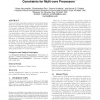466 search results - page 12 / 94 » Using Queue Time Predictions for Processor Allocation |
EWC
2008
13 years 7 months ago
2008
In parallel adaptive mesh refinement (AMR) computations the problem size can vary significantly during a simulation. The goal here is to explore the performance implications of dyn...
SIGMETRICS
2005
ACM
14 years 1 months ago
2005
ACM
In addition to providing small mean response times, modern applications seek to provide users predictable service and, in some cases, Quality of Service (QoS) guarantees. In order...
IPPS
2007
IEEE
14 years 1 months ago
2007
IEEE
This study examined the interplay among processor speed, cluster interconnect and file I/O, using parallel applications to quantify interactions. We focused on a common case wher...
ISHPC
2003
Springer
14 years 22 days ago
2003
Springer
Instruction issue consumes a large amount of energy in out of order processors, largely in the wakeup logic. Proposed solutions to the problem require prediction or additional hard...
DAC
2009
ACM
14 years 2 months ago
2009
ACM
It is known that temperature gradients and thermal hotspots affect the reliability of microprocessors. Temperature is also an important constraint when maximizing the performance...

